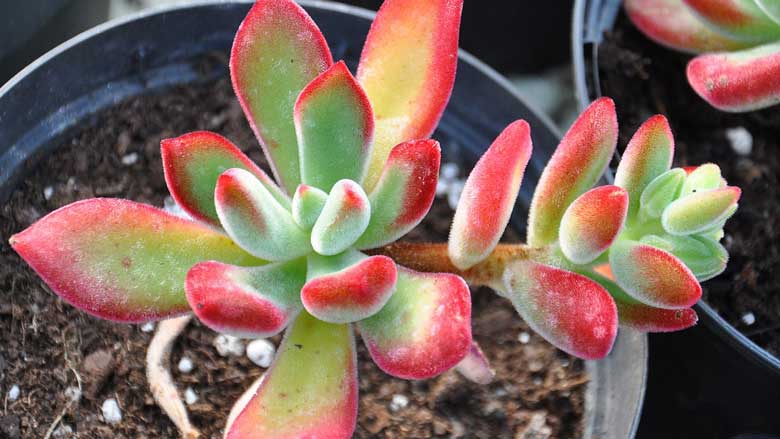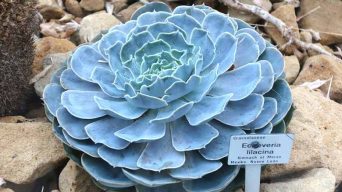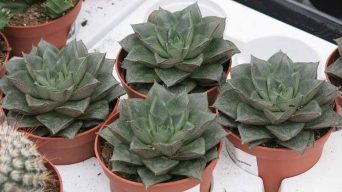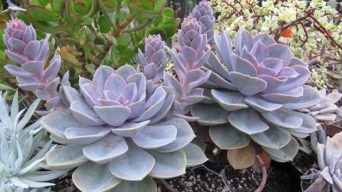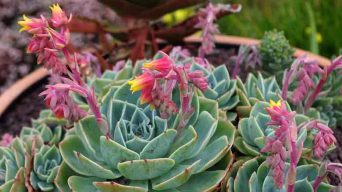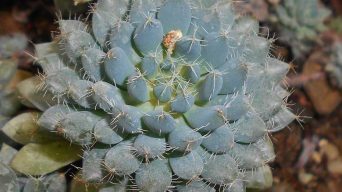There are many different types of succulents to choose from.
The Echeveria pulvinata, commonly referred to as Chenille Plant for its fuzzy fleshy leaves, is a beautiful indoor plant and a great choice for those looking for an easy-to-care-for plant.
Here we will go over how to care for Echeveria pulvinata in order to help you keep these beautiful plants alive long-term.
The Echeveria Pulvinata (Chenille Plant)
The Echeveria pulvinata, also known as the Chenille Plant, is a succulent rosette that belongs to the Crassulaceae family. The plant is often found in Mexico, Costa Rica, and South America.
The leaves are green with a red-brown stripe pattern that is noticeable on the bottom of the leaf.
The flowers have pinkish petals and can grow up to 20 centimeters tall. The leaves of the Echeveria pulvinata are big, thick, and fleshy.
The succulent can grow up to 30 cm tall and 15cm wide in a pot.
How To Care for Echeveria Pulvinata (Chenille Plant)
Sun Exposure & Light Requirements
Echeveria pulvinata plants grow best in a bright but not too hot environment. They also require some direct sunlight to be healthy when grown indoors.
Indoors can do well with a north-facing window or east/west-facing windows that get plenty of light throughout the day.
However, outdoor exposure should only include an hour or two of sun after the plant has been acclimated to its new home. Gradually increase access time as needed for it to adjust without burning up.
A south-facing window is not recommended because they are typically hit by more intense solar radiation than other areas. It will likely burn if placed there even briefly during peak hours (midday).
When your Echeveria pulvinata is in an area where it does not receive sufficient light at least four hours per day, supplement with artificial lighting during low-light seasons.
Watering
For the first two weeks, water your Echeveria pulvinata sparingly. Echeveria will produce roots in time as long as they are kept constantly moist.
When watering, do not pour any more than a tablespoon of water at a time into the pot. Ensure it has drained properly before adding more (it may take up to five minutes for all the liquid to drain).
Once you notice new growth, increase how often you water gradually until you are watering every day or every other day during the growing season.
Remember that overwatering is very common with this plant, so keep an eye on soil moisture levels when using automatic sprinkler systems. Too much water can cause root rot which leads to death.
Echeveria is tolerant of underwatering, but best to avoid it as this can cause leaves to turn brown and curl up at the edges. Brown or crispy-looking leaves are a sign that your Echeveria needs water, so don’t hesitate to give them what they need!
This plant should be watered every day or every other day during its growing season, which can last from mid-spring until late fall, depending on where you live.
In warmer regions, they may need water once per week at most due to how quickly they will dry out since their soil doesn’t hold moisture.
Soil should be allowed to dry out a bit between waterings and not be kept constantly damp or wet for prolonged periods.
This will also reduce the chance of root rot happening if you forget to give them another drink before they go thirsty again.
Soil
Echeveria pulvinata prefers a well-drained soil mix such as cactus potting mix, soilless mixes, or a mix composed of 50% organic matter.
The soil should be well-drained and allow water to drain freely from the pot to prevent root rot and other fungal infections.
It prefers a cactus mixture with half organic material. Still, it can also thrive in soilless mixes as long as they are well-draining.
The plant needs good drainage because it has an extensive root system that will become damaged if left sitting in stagnant water for too long.
The addition of sand or perlite/vermiculite helps improve drainage by adding pore space for water to flow through the rooting zone instead of sitting on top, reducing the risk of rotting roots and fungal infections from stagnant water.
Temperature and Humidity
The Echeveria pulvinata thrives in temperatures from 20°C to 30°C with a humidity of 50-70%.
When the weather becomes too hot, they will stop growing. When it is below 17 ° C (62.60 ° F), water your plant less frequently and only give enough water so that there is no dry soil on top of the rhizomes.
Echeveria pulvinata prefers a constant temperature with slight fluctuation in humidity levels throughout the year to maintain their growth rate.
But it can handle temperatures as low as 50°F and 60% relative humidity if necessary to survive winter outside its natural habitat.
Echeveria pulvinata is from dry, hot climates and can withstand cool temperatures as low as 50°F without damage.
They do not like cold drafts from windows or doors that could cause them to freeze at the roots, so make sure they get plenty of warmth for indoor winter growing conditions.
When plants have enough light but are colder than desired, keep daytime temperatures above 55 °F with a relative humidity of around 60% or higher by using an incandescent bulb in addition to natural sun exposure.
Keep nighttime temps below 65 degrees Fahrenheit if possible. This will help maintain the plant’s flowering cycle through winter when days grow shorter and nights grow cooler.
If you notice leggy growth on your Echeveria, this is a sign that they are not getting enough light.
Fertilizing
Echeveria pulvinata is a succulent which needs some extra care in regard to fertilizing.
To make sure your Echeverias are healthy and growing, you need to use a slow-release fertilizer.
You also want to avoid using high nitrogen fertilizers on your plants. They can cause them stress and even lead to death if used heavily year after year.
The best time to fertilize is once every six months during dormancy when they are not actively growing.
You can apply a slow-release fertilizer to the soil or use liquid fertilizing.
Echeveria pulvinata will also need some supplementary feeding during their active growing season from March until October.
It would help if you fed your plants every two weeks, using each time about one-quarter of what would be used when they are in full growth mode.
Liquid fertilizers work well for echeverias because they are absorbed quickly into the plants and are less likely to burn them.
Other types of fertilizer are more likely to burn the plant. For example, dry powders that have been sitting on the plant’s roots too long before leaves need them, stems, and flowers.
Potting and Repotting
Knowing how and when to pot or repot your Echeveria is essential.
It will depend on the size of the plant, the type of medium you are using, whether or not it is potted in a container with drainage holes, etc.
An Echeveria succulent plant can be kept in its original container until it begins growing roots through the bottom (or if there’s too much water). When this happens, then transplanting into another pot may become necessary.
A good rule of thumb is that your Echeveria should have at least two inches between the soil and the rim. This allows that excess moisture does not build up due to evaporation from watering.
Potting an Echeveria pulvinata is not very difficult.
You can use the same methods to pot a succulent as any other type of plant in your garden.
It’s always best to grow these plants outdoors if possible. They need plenty of sunlight and are easy to propagate by taking cuttings from them and planting those outside when there’s sufficient light.
- First, choose a container with drainage holes on the bottom or put rocks on the bottom before adding soil so it won’t absorb too much water.
- Fill with the moistened potting mix, then place the echeverias root ball side down into the center of this new mixture.
- Fill in around the Echeveria pulvinata with potting soil until it is buried up to its original root ball size.
- Water well so the new earth has been soaked, and place your plant where there’s plenty of sunlight.
It can take anywhere from two weeks to six months for an Echeveria pulvinata to start growing again after being repoted outdoors.
However, this depends on how much light they are getting when planted outside, so make sure to keep them watered regularly.
Pruning
Echeveria species are relatively low-maintenance plants, and the Echeveria pulvinata is no exception.
Pruning Echeverias should be done to keep them healthy, but it isn’t usually necessary to do this very often.
If you choose to prune your plant, wait until new growth starts in spring or summer before cutting off any old leaves that are beginning to look dull and dry.
You can also remove a few of the oldest leaves from around the base of the plant if they start getting brown spots on them.
In general, Echeveria species are slow-growing plants, so any pruning that is done should be very conservative. It’s usually best to wait until you notice the plant needs it before doing anything at all.
They can survive even if their leaves start getting a little brown or dry because of low humidity levels in your home.
Just make sure not to overwater them as this will cause more leaf problems instead of solving them and may lead to rot on the part of the stem or root system too!
Pests and Diseases
You should be aware of some pests and diseases when it comes to Echeveria pulvinata plants.
The most common pest is the Mealybug. If they aren’t dealt with quickly, these tiny creatures can cause significant damage to your plant.
Mealybugs secrete a waxy substance that coats the leaves, resulting in curling or yellowing leaves from lack of sunlight exposure. In severe cases, this issue could also lead to death if not treated right away.
There are many ways to target these pests.
One is to use a cotton swab dipped in rubbing alcohol and carefully remove the pests with it. You can also purchase natural remedies designed specifically for these types of issues from your local gardening store.
A fungal disease called Echeveria leaf spot will occasionally affect this plant. Still, if you keep up with watering practices, there won’t be any problems.
This fungus usually starts as small brown spots on leaves, which quickly grow to become larger, or they might appear as yellowish-brown patches.
The size gets bigger until the entire leaf turns brown and dies off completely unless treated immediately with fungicide spray or powder – whichever works best for your situation.
It’s important to note that plants may be more susceptible to its recurrence once affected by this issue.
It’s recommended that you remove the infected plant parts, stop watering, and expose the leaves to direct sunlight for several hours a day.
How To Propagate Echeveria Pulvinata (Chenille Plant)
Echeveria pulvinata “Chenille Plant” can be propagated from leaves and stem cuttings. The stem cuttings will take a long time to root, while the leaves are faster.
Leaf Cutting
Echeveria pulvinata propagation can be done through leaf cutting.
To propagate Echeveria, cut a healthy-looking leaf from the plant and allow the leaf to dry out for a few hours.
Make sure to cut the leaf with some of the stem attached, making it easier for roots to form in water.
Once your Echeveria has dried out, place it into a pot or cup and cover it with moistened soil just before the top of the root ball is exposed from beneath the surface.
Place the Echeveria in a sunny spot and water at least twice per week using room temperature filtered water.
Allow about two months before transplanting since Echevers take time to grow roots and become dependent on their new environment.
Stem Cutting
Echeveria pulvinata stem cutting propagation is a great way to propagate this succulent plant. To propagate this chenille plant easily, follow these steps:
- Take a cutting of the Echeveria pulvinata. Cut about an inch off of one side, and cut it so that you have two straight sides (as if making a cross shape).
- Take your plant pot or container with soil in it. You can help prevent rot by placing a handful of wet sphagnum moss at the bottom.
- Place your Echeveria pulvinata cutting in the soil with the cut side facing down. The stem should be about an inch or two below soil level, and the leaves mustn’t be buried.
- Water your plant to provide enough moisture for root growth before placing it back into its original environment, including a sunny window.
Your chenille plant will start growing new roots from this point on. Don’t forget to water regularly!
Seed
Succulent plants are very easy to grow from seed.
Take a handful of soil (enough for 50 or so) and spread it evenly over top of an individual pot with drainage holes in the bottom, such as a cake pan.
Place one seed on top of the dirt surface at least ¼ inch away from all sides of the container, then gently cover them up with another thin layer of dirt.
Then wait until they sprout–this usually takes about two weeks after you sow them. It can be challenging to tell when this happens because, like most seeds, they’re tiny and difficult to see.
After that point, you should start watering regularly, which will help the roots grow.
The best way to monitor when your Chenille plant needs water is by touching the soil every day, if it feels dry, then you need to give it some more.
Ensure not to overwater, though, as this can cause root rot or mold if there isn’t enough drainage for excess moisture/water vapors.
Toxicity
The Echeveria pulvinata plant is not toxic to people or pets
Sensitive individuals (especially those with allergies) can have a reaction from handling plants like Echeveria pulvinata.
Its sap contains calcium oxalate crystals that can cause skin irritation and discomfort if they come in contact with the skin.
But this will only be a problem if these parts come into contact with your skin or eyes.
It won’t affect you just by being around them in the air or touching other surfaces where they’ve spilled any residue of the liquid.
Final Thoughts
The Echeveria pulvinata “Chenille Plant” is a beautiful and easy to care for succulent.
They look great in almost any setting and are not picky about their environment.
With time and patience, this plant can grow into a large specimen that can thrive in any home.

